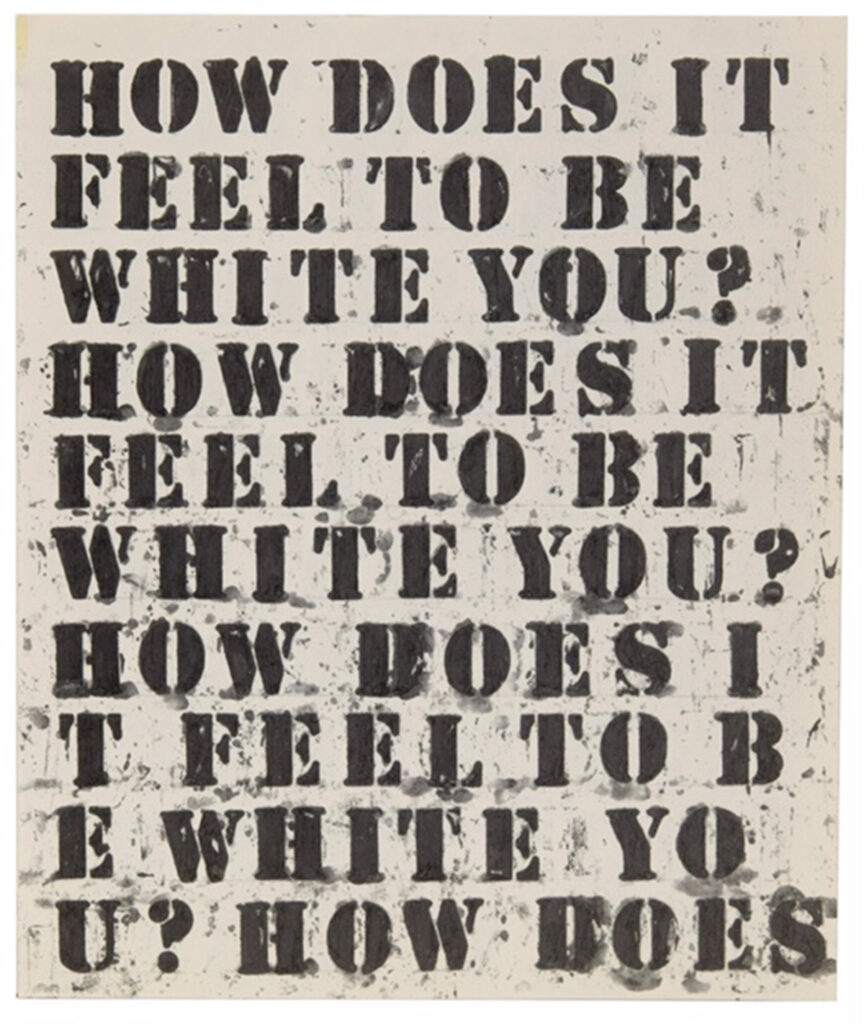
This Glenn Ligon lithograph ‘How Does It Feel To Be White You’ is paired with ‘Changes’ by the late great rapper Tupac Shakur as part of the ‘Marks by Modern Masters’ exhibition at the Riverfront Museum.
When imagining the types of things you might find when entering a museum, you would think of paintings, drawings, sculptures, installations, conceptual works, and the like. But as the lines between contemporary art and music change, an explanation of cultural context may be needed.
For example, to give someone an understanding of its meaning without the context of music, there needs to be a relationship between the artwork and the viewer. While artistic disciplines find their way into art history, they are typically only there to aid in understanding other works and are not given referential musical recognition.
At the Peoria Riverfront Museum exhibition “Marks by Modern Masters,” we will look at music and its ability to increase connections between the worlds of art and modern popular music.
There are many reasons why music has been left behind in the annexes of art history. First and foremost, music is not visual, so you cannot open a book and experience the work like you can with a picture of a painting. Like visual artists, laying out the musician’s social context and influences are integral to understanding the relationship between art and music. The Peoria Riverfront Museum realized it was time to bring equity to both the visual arts and music.
Enter Demarcus Hamilton, a.k.a. Marc Supreme. Through this Hip-Hop DJ, journalist, and now guest Museum curator, he allows us to further understand these works of art through our eyes and ears.
Music with a message
Through contemporary music, he cites lyrical references, as well as how they use sound, to convey a musical message. Additionally, he allows us to understand how artists within a specific framework, movement, genre, or even the political climate inspire a song.
Artists and musicians are inveterate cultural borrowers who harvest ideas from the whole realm of human experiences. A visual artist encountering a work of art will look to see if there is anything of use for their own practice, be it in terms of process, idea, material, or tendency. These are the ones who are able to make use of the content as social context to make a contemporary statement that enriches their own work. And they manage the skill of interpretation equally and with the necessity to negotiate our world of visual complexity and richness.
In the Owens Gallery’s “Marks by Modern Masters,” Supreme takes his observation of a specific work of art and interprets the visual experience through music.

‘The dark layered arcs of ‘Paths and Edges’ seem to have a downslope rolling effect that continues beyond the paper. The backdrop of the well-known Adele song ‘Rolling in the Deep’ just fits.” — Marcus Supreme
Sound system
Look at Richard Serra’s print, “Paths and Edges,” a bold, richly textured semi-circular image with detritus and ragged lines, and then listen to Marc’s selection of singer Adele’s song “Rolling in the Deep.” As the DJ states, “The dark layered arcs seem to have a downslope rolling effect that continues beyond the paper. The backdrop of the well-known Adele song just fits.”
There is a staggering number of genres in music ranging from all manner of time periods and geographical locations that allow additional meaning to contemporary art. In particular, Hip-Hop with its musical style of speech is rhythmically sung to an accompanied musical score. Because the words are concerned with emotional sounds that convey cultural influence and melody, they are incongruous with this contemporary art form. The elements of music sound, rhythm, cadence, emotional inflection, and harmony, are both similar and dissimilar to the elements of art: line, color, form, and texture.
Marc Supreme took these elements and the nature of the genres to heart when he paired Glenn Ligon’s lithograph “How Does It Feel to be White You” with Tupac’s song “Changes” from 1998.
“The inverse of ‘How it feels to be white you?’ would be ‘How does it feel to be the Black me?’ ” Supreme points out. “Tupac’s ‘Changes’ provides a response to the question by examining one lens of the Black experience in America. Just as the stark, black text on white paper, Tupac’s delivery is raw and eloquent.”
Supreme added a language of rhythm, enunciation, and energy to the art exhibited in “Marks by Modern Masters” which alters the museum experience.
When viewing Ed Moses’s three prints from his “Wedge” series, Supreme was drawn to Moses’s rhythmic mark-making.
“The same way that Ed Moses explored a multitude of approaches to mark making, J. Cole explored a different approach in ‘Folding Clothes’ almost to the extent where it was barely accepted by the masses because it didn’t match the traditional sounds of prominent Hip-Hop artists of the time,” Supreme said. “The same goes for the trio pieces. They are difficult to wrap your head around given the pieces in the rest of the gallery. They don’t look like wedged works — more like button-up shirts.”
This act of curation led Marc Supreme to conduct an interview with Alfred Conteh, a Black contemporary artist whose work is currently included in the Museum’s exhibition, “American Revolutionaries: Art and Disruption.” Conteh’s painting “Malik and Marquis,” depicts two middle schoolers standing proud and respectful, poised and looking directly at the viewer. Undaunted, the pair are captured in casual dress, exemplifying their unnoticed lives. Conteh’s brilliance in creating an eroding background that infringes upon the figures makes this a portrait of survival and confidence unscathed by society’s disenfranchised.
Both “Marks by Modern Masters” and “American Revolutionaries: Art and Disruption” will remain up through Summer 2023 at the Peoria Riverfront Museum. Come and take a look and listen.

Recent Comments